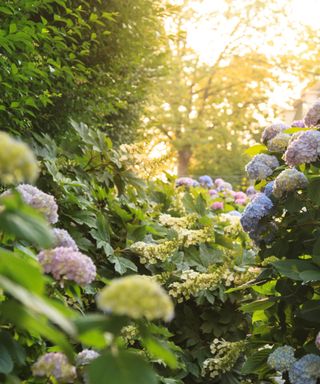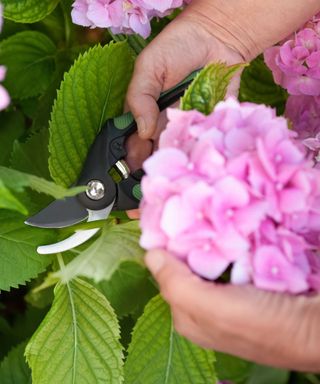

You don't need to worry just yet if you're peering into your backyard and can't see your hydrangea blooming.
I've asked gardening experts why it might be failing, and they all agree there are five possible problems. From poor sunlight to weak watering, they're all easy mistakes to make — but are thankfully quick to fix.
If you're taking care of hydrangeas and can't see any colorful petals or flower heads, it's time to take some action to salvage the season's lost blooms.
The five reasons why hydrangea is not blooming in your backyard
Whether you're wondering why your hydrangeas are drooping or if they just aren't producing flowers, these tips will help you sort the problem out.
My gardening experts have recommended useful buys throughout, which I've curated from trusted retailers, as well as putting together a hydrangea care essentials to help you fix any issues.
The prices below were correct at the time of publication.
1. Not enough sunlight

Typically, the number one reason hydrangeas don't bloom is not enough sunlight.
“Hydrangeas require at least 6 hours of direct sun to produce flowers,” says Bob Berriz, gardening and landscaping expert at Berriz Design.
He suggests finding a spot with increased light exposure, ideally one with morning sun and afternoon shade.
2. Improper watering

I know it can be tempting to give TLC to your hydrangea, but both over watering and under watering can stress hydrangeas and prevent blooming.
“Hydrangeas need consistent moisture but well-drained soil,” explains Tony O’Neill, gardening expert at Simplify Gardening.
Water deeply once or twice a week, depending on rainfall, and ensure the soil drains well. I recommend finding a colorful watering can, as I find having this makes it easier to spot in the backyard, and serves as a visual reminder to pick up, and water.
The Pioneer Woman Folk Geo Metal Watering Can from Walmart has a boho pattern and can be used indoors and outdoors, for example. You can also use a soil meter to check whether a plant needs watering or not, such as the Amazon number one bestselling XLUX Soil Moisture Meter.
3. Poor nutrients

Just like you and me, plants need the right nutrients to thrive, and a lack of these can may be why your hydrangea is not blooming.
“Fertilize your hydrangeas with a balanced, slow-release fertilizer in early spring,” Tony suggests. He advises giving high-nitrogen fertilizers a miss, as they promote leaf growth over blooms.
This is why it’s a good idea to choose ones that are flower-specific, such as the Miracle-Gro Water Soluble Bloom Booster from Amazon which gets to work quickly and is safe to use on annuals and perennials.
4. Pests

If you’ve learned how to identify pests and have spotted these in your yard, this could be affecting your hydrangeas and stopping them from reaching their full potential.
“Pests like spider mites, aphids, and Japanese beetles can damage new growth and buds,” says Joe Gerrior, gardening and landscaping expert at Gerrior Masonry & Landscape. “Treating the infestation early will prevent damage to buds and new growth.”
I’ve been dealing with aphids while growing vegetables in my backyard and I recommend putting dish soap and water in a spray bottle, spritzing the area, and wiping them away with kitchen towel. It's been brilliantly effective on my veg patch.
5. Incorrect pruning

Learning when to prune hydrangeas is an important part of making sure they thrive
“Pruning at the wrong time of year can remove the flower buds that develop on old wood,” Tony says. “For bigleaf and oakleaf hydrangeas, prune right after they bloom in the summer, while for panicle and smooth hydrangeas, prune in late winter or early spring before new growth begins.”
Tony adds that pruning surrounding trees and shrubs can also allow more light to reach the plant. Whenever you need to prune, make sure to use sharp pruning shears to avoid damaging the plant, and give them a clean to avoid introducing microbes or fungus to the delicate freshly-cut area.
I like the look of the Gonicc Professional Premium Titanium Bypass Pruning Shears from Amazon, which have over 20,000 five-star reviews from shoppers who rate the ease of use and quality material and have come highly recommended by many of our gardening writers and experts at Real Homes.
Hydrangea care essentials

Size (in.): H5.5 x W9 x D15.5
Made from: Copper
Price: $32.99
Hydrangeas are some of the most stylish flowers out there, so it just makes sense to water them with an equally chic can. It's available in either an elegant copper or cute teal design and has a 60 oz capacity that makes it light enough for kids to help with watering, too.

Size: 32 oz.
Weight: 4.88 pounds
Price: $19.74 for two
The famous Cutter spray is the backyard bug spray gardening pros always use. All you have to do to remove your hydrangea pests is flip the hose switch and spray where required. I advise using this sparingly and just around the edges of your hydrangea plant pot, as shoppers say to be careful using it around plants.

Size: 0.31 lbs
Made from: Stainless steel
Price: $10.95
These stainless steel pruning shears from Amazon's own range are the perfect size for smaller jobs like pruning hydrangeas, other flowers, and thin branches. The non-slip TPR handle will allow comfort when trimming, while the high-tension coil will ensure precision.
Listening to expert-approved advice and tackling why your hydrangea isn’t growing flowers will ensure you see pretty petals soon enough.
“Following these tips has helped many of my clients get their hydrangeas blooming beautifully again,” Joe finishes by saying.
Once you’ve solved this problem, you can start getting creative with this plant by learning how to change the color of hydrangeas.
Join our newsletter
Get the best home decor ideas, DIY advice and project inspiration straight to your inbox!

Hi there! I’m a content editor at Real Homes. I've been a lifestyle journalist for over five years, previously working as an editor across regional magazines. Before this, I graduated from Nottingham Trent University a degree in journalism, along with an NCTJ gold diploma. I love running, decorating my rented Victorian home, and discovering new cheeses. For Real Homes, I specialize in interior design, trends and finding the best viral buys.